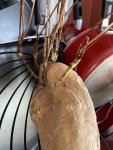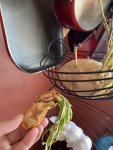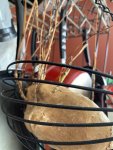Since I'm not sure on the onion (generally start those from seeds myself) I'm only going to address the potato. Well, other than to say that the onion bulb itself is basically the "root" of the plant and those shoots are actually the onion attempting to start growing a new plant from the energy stored in the onion bulb.
It's a similar situation with that potato where those "roots" are actually the start of a new plant - and not the roots as the potato itself is the root where the plant stores it's energy. Those shoots are often referred to as "eyes". So on that note the potato can keep until the soil is workable (in your area) this spring and planted directly into a soft workable soil (think more akin to compost than heavy sludge-like clays). The nice thing is that potato can actually be sub-divided for multiple plants, you just need to cut it so there's an eye/shoot on each piece and each piece is no smaller than roughly 1inch (or larger) on each side - larger provides more energy for a plant to get started. Which also means that on the end with multiple eyes close together, you *may* want to break off the smaller eyes so they don't compete with the larger/healthier ones before you can get it planted.
A good resource for getting started in gardening can be found here:
Growing Potatoes – Bonnie Plants - it's one of the many one I've found useful for a reference, as well a source for learning how to grow new types of vegetables I haven't grown before.










